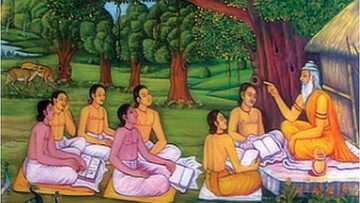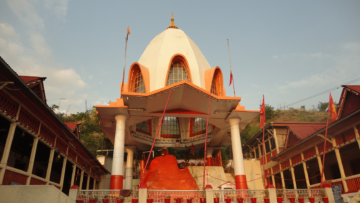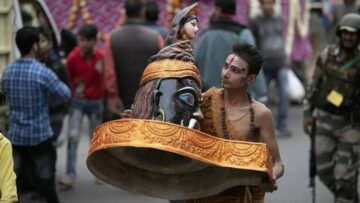A robust community life was one of the striking features of our 5000-year old civilization, free-flowing since its birth, drawing spiritual sustenance, prospering and proliferating as it percolated beyond the boundaries of the present day Bharat, the flaming embers of which continue to light the Indic skies even today. The reason for its survival even today is its sheer dynamic nature – never static, never resting, always absorbing and assimilating quality. Due to this ever-evolving dynamic nature of Indic Civilization, the relationship between the Individual and the Community has been its most unique feature cutting across the eons of time.
Indic reflections always sought to mandate human life by setting unambiguous objectives or codes, namely the Chaturvidha Purusharthas – the four goals of humankind – Kama, Artha, Dharma and Moksha. Desires (Kama) and wealth (Artha) are regulated by Dharma while still pursuing a parallel journey seeking Moksha. Interestingly there was no particular template of dharma for all. The natural human tendencies – Swabhava defined the individual’s duties – Swadharma, calling out the best in a person which ultimately helped in the growth of an individual and the community at large seamlessly flowing towards the path of Kalyan and Mangal.
The core general concepts of peace, spiritual purity and enlightenment helped Buddhism and Jainism too find a community space for themselves, but contemporary times, especially following the British colonial era brought along an entirely new Jurisprudential Perspective discourse of rights – ‘demanding what is rightfully yours.’ This was a tectonic shift from the prevalent concepts of inner engineering of a Sanatani which was synchronized with the notion of Dharma – which was engrained in the very DNA of the Indic society. Even the Kings were not spared if they swerved from the path of Dharma, as the punishment for them was manifold. This beautiful synthesis of Dharma and social welfare gave birth to what was the florescence of an inward-gazing community and civilization.
Today we are trying to ape the west simply forgetting that the very foundations of their few hundred-year-old civilization was built on the death and destruction of the indigenous natives who were not white enough to be cultured. We know what happened to the Cherokee, Apaches and Sioux tribes of North American and Aboriginal Australians, Maoris in the Southern continent. The two major Abrahamic cultures who operate by the dogmatic premise of a single book and single god have consistently tried to impose their credence over the entire world.
For any individual or community to flourish and propagate, the rudimentary condition is its constant geography because when groups get uprooted from their natural environs, survivalism takes precedence and results in dilution of the social fabric. Unfortunately over the last few centuries, the Islamic perpetrators followed by the British colonial conquests with their cavalier disregard for this peace loving indigenous people systemically attempted to destroy, not only our temples and our cities, but our very ethos – our very culture and civilization. The most recent occurrence of this phenomenon has resulted in indigenous people of the land known as Heaven on Earth and considered to be The Crown of India being pushed away from their natural geography just about three decades ago. If this is not a wakeup call for the rest of us, then what is?
The question that arises now is can the repository of our indigenous epistemology survive? Yes, instincts of survivalism come to the fore when displaced people spent some time in finding new soil to root firmly and blossom, but ultimately realize that after all, the entire land of Bharatavarsha is replete with divinity, spiritualism and cultural consciousness. This is because a Sanatani instinctively creates a sacred space for himself and realigns to form new communities.
The key to reclaiming our individuality and community life is revivalism. This is what the likes of Lokmanya Balagangadhar Tilak did during the freedom movement; instilling a sense of pride and self-confidence in our youth; making them aware of their rich cultural heritage. Rewriting history books can be a great start – after all the first step towards making the nation great would be to provide the young fertile mind with exemplary ideals – Privthraj Chauhan, Chandragupta Mauryas, Rana Pratap, Shivaji Maharaj, the Cholas, Pandiyans and Pallavas, who can replace the barbarians littered shamelessly smearing every chapter of the textbook. How about our ancient spiritual wisdom becoming mainstream with discourses on Gita entering the classroom! All these efforts will require Tapasya which expects us to overcome our Arishadvarga. Our success depends on our ability to build a Discourse with all aspiring Indic Communities around us.
After all, we are the people who instinctively do a lot of things in daily lives – like every time our foot touches a book, we with reverence touch it with our hands and place the very hands-on our forehead or eyes as a mark of apology. No one has taught us this. We just do it!
Note from Chief Editor: We are starting a new series Editor’s Note which will be a commentary on current social or political issues that have a direct impact on Indic civilisation. This series will be penned either by our editors or invited scholars. It will attempt to comment with an intent to bring a Shastric and Ancient gaze on contemporary reality.
Image Credit: picxy
Disclaimer: The opinions expressed in this article belong to the author. Indic Today is neither responsible nor liable for the accuracy, completeness, suitability, or validity of any information in the article.











